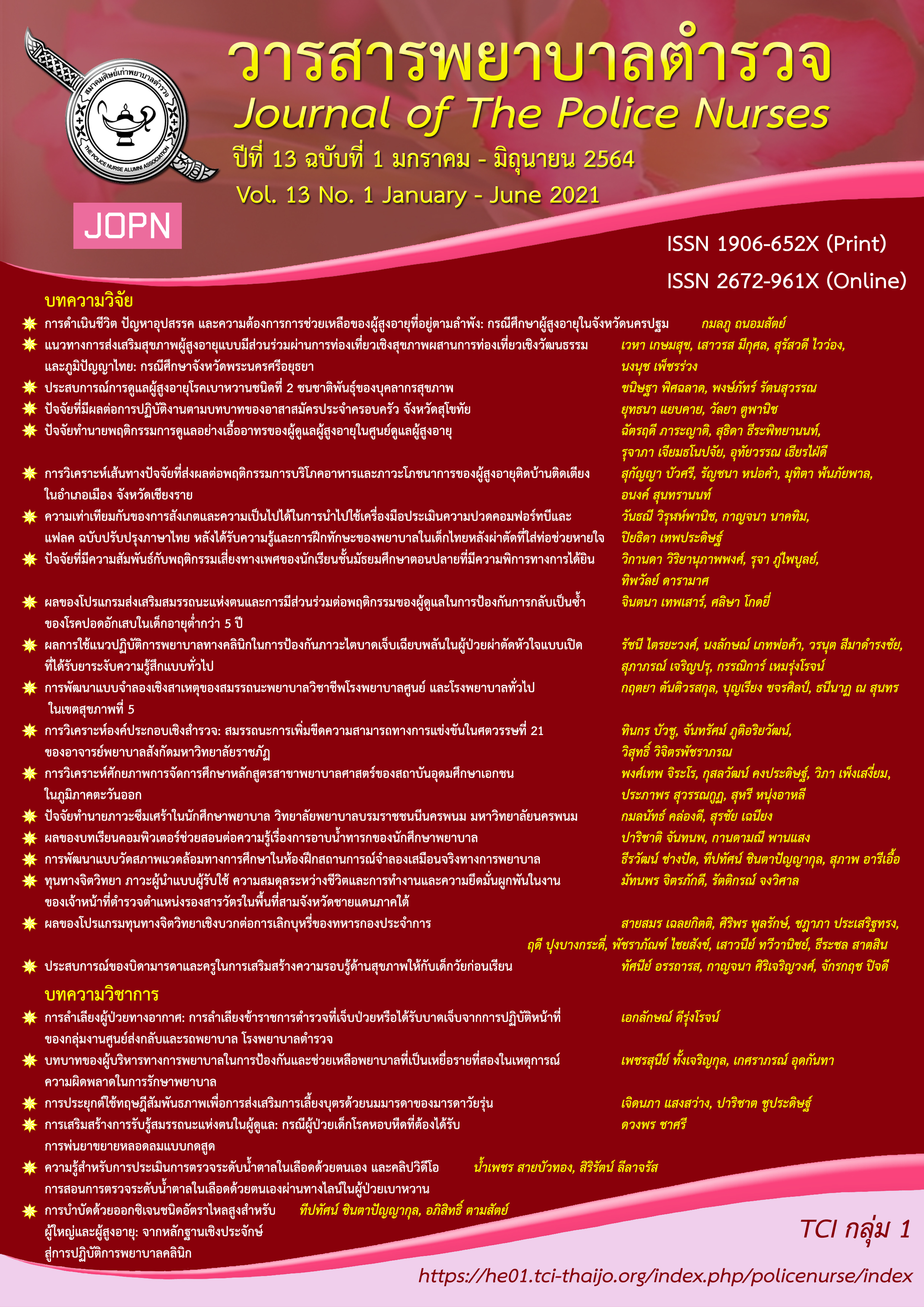การวิเคราะห์เส้นทางปัจจัยที่ส่งผลต่อพฤติกรรมการบริโภคอาหารและภาวะโภชนาการ ของผู้สูงอายุติดบ้านติดเตียงในอำเภอเมือง จังหวัดเชียงราย
คำสำคัญ:
การวิเคราะห์เส้นทาง, พฤติกรรมการบริโภคอาหาร, ภาวะโภชนาการ, ผู้สูงอายุติดบ้านติดเตียงบทคัดย่อ
การวิจัยนี้มีวัตถุประสงค์เพื่อศึกษาปัจจัยที่ส่งผลต่อพฤติกรรมการบริโภคอาหารและภาวะโภชนาการของผู้สูงอายุติดบ้าน ติดเตียง โดยใช้การวิเคราะห์เส้นทาง ตัวอย่าง คือ ผู้สูงอายุติดบ้านติดเตียงในอำเภอเมือง จังหวัดเชียงราย ที่ได้มาจากสุ่มตัวอย่าง จำนวน 135 คน เครื่องมือที่ใช้ในการวิจัยเป็นแบบสอบถาม ได้แก่ 1) ปัจจัยนำที่แบ่งเป็นความรู้และการรับรู้ประโยชน์ 2) ปัจจัยเอื้อ 3) ปัจจัยเสริม 4) พฤติกรรมการบริโภคอาหาร และ 5) แบบประเมินภาวะโภชนาการ ซึ่งผ่านการตรวจสอบความตรงเชิงเนื้อหาจากผู้เชี่ยวชาญ จำนวน 5 ท่าน และมีค่าความเที่ยงของแบบทดสอบความรู้และการรับรู้ประโยชน์ที่เป็นค่า KR-20 เท่ากับ .84 และ .96 ตามลำดับ มีค่าสัมประสิทธิ์แอลฟาของครอนบาคของแบบสอบถาม 2-5 เท่ากับ .87, .87, .74 และ .85 ตามลำดับ เก็บรวบรวมข้อมูลตั้งแต่ กุมภาพันธ์ ถึง กรกฎาคม พ.ศ. 2563 วิเคราะห์ข้อมูลโดยใช้ความถี่ ร้อยละ ค่าเฉลี่ย ส่วนเบี่ยงเบนมาตรฐาน และการวิเคราะห์เส้นทาง
ผลการวิจัยพบว่า 1) พฤติกรรมการบริโภคอาหารมีอิทธิพลทางตรงเชิงบวกต่อภาวะโภชนาการโดยมีค่าสัมประสิทธิ์ขนาดอิทธิพลเท่ากับ .74 2) ปัจจัยนำ ปัจจัยเอื้อ ปัจจัยเสริม มีอิทธิพลทางอ้อมต่อภาวะโภชนาการผ่านพฤติกรรมการบริโภคอาหาร และตัวแปรทั้งหมดร่วมกันอธิบายความแปรปรวนของภาวะโภชนาการของผู้สูงอายุติดบ้าน ติดเตียง ได้ร้อยละ 55 ดังนั้น ผู้สูงอายุติดบ้านติดเตียงควรได้รับการส่งเสริมพฤติกรรมการบริโภคอาหารที่ดีควบคู่กับการส่งเสริมปัจจัยนำที่เป็นความรู้และการรับรู้ประโยชน์ ปัจจัยเอื้อ และปัจจัยเสริม เพื่อให้มีภาวะโภชนาการดีต่อไปในอนาคต
Downloads
เอกสารอ้างอิง
Abellan, G. V., & Vellas, B. (2011). Is the mini nutritional assessment an appropriate tool to assess frailty in older adults. Journal of Nutrition, Health & Aging, 15(3), 159-160.
Agarwalla, R., Saikia, A. M., & Baruah, R. (2015). Assessment of the nutritional status of the elderly and its correlates. Journal of Family and Community Medicine, 22(1), 39-43.
Aekplakorn, W., Pukcharoen, H., Thaikla, K., & Sathiennoppaklao, W. (2016). The 5th National Health Examination Survey in Thailand 2014. Nonthaburi: Health System Research Institute.
Chiang Rai Provincial Public Health Office. (2016). Elderly statistics. Retrieved from http://61.19.32.29/hdc/main/index_pk.php
Chumkaew, K., & Rungsayatorn, S. (2014). Knowledge, attitude, and food consumption behavior of the elderly in Songkhla province. Kasetsart Journal of Social Sciences, 35(1), 16-29.
Department of Health. (2020). Long term care. Retrieved from http://eh.anamai.moph.go.th/main.php?filename=LongTremCare
Duangjina, T., & Panuthai, S. (2020). Nursing intervention for improving nutritional status in older persons. Nursing Journal, 47(3), 469-480.
Duangjina, T., Panuthai, S., & Suwankruhasn, N. (2020). Food consumption behaviors and nutritional status in dependent older persons. Nursing Journal, 47(1), 231-241.
Dudex, S. G. (2018). Nutrition essential for nursing practice (8th ed.). Philadelphia, PA: Lippincott.
Foundation of Thai Gerontology Research and Development Institute. (2019). Situation of Thai elderly 2016. Bangkok: Deuan Tula Printing House.
Gray, R., Pattaravanich, U., Chamchan, C., & Suwannoppakao, R. (2013). New concept of older persons: The psychosocial and health perspective. Nakhon Pathom: Institute for Population and Social Research, Mahidol University.
Green, L. W., & Kreuter, M. W. (2005). Health promotion planning: An educational and environmental approach (4th ed). New York, NY: Mc Graw-Hill.
Heather, H. K., Carrier, N., Slaughter, S. E., Lengyel, C., & Steele C. M. (2017). Prevalence and determinants of poor food intake of residents living in long-term care. Journal of the American Medical Directors Association, 18(11), 941-947.
Hox, J. J., Moerbeek, M., & van de Schoot, R. (2018). Multilevel analysis: Quantitative methodology series, techniques and applications (3rd ed.). New York, NY: Routledge.
Kline, R. B. (2015). Principles and practice of structural equation modeling. New York, NY: Guilford publications.
Maneerat, W., Laowongsa, J., Kunaan, K., Paisarn, S., & Leumteum, K. (2017). Food consumption behavior of the elderly: Case study of Mae Khaw Tom sub-district, Muang district, Chiang Rai Province. Kasalongkham Research Journal, 11(3), 135-143.
Mekwimon, W. (2012). Factors related to food consumption behavior of the elderly in Samutsongkram Province (Research Report). Bangkok: Suan Sunandha Rajabhat University.
Ministry of Public Health. (2021). Manual for screening and assessing elderly health 2021. Retrieved from http://www.tako.moph.go.th/takmoph2016/file_download/file_20210129131952.pdf
Muurinen, S., Soini, H., Suominen, M., & Pitkälä, K. (2010). Nutritional status and psychological well-being.
e-SPEN, the European e-Journal of Clinical Nutrition and Metabolism, 5(1), 26-29.
Office of the National Economic and Social Development Council. (2015). Population statistics. Retrieved from https://www.nesdc.go.th/main.php?filename=social
Panutat, S., Chuto, C., Nuntawan, C., Pumsrisawat, A., & Pruksacheva, T. (2017). Caring for the elderly with malnutrition. Journal of Ratchathani Innovative Health Sciences, 1(1), 1-15.
Ponpai, S., Techakriengkrai, T., & Limsuwan, T. (2016). Nutritional status of well elder, home bound elder and bed bound elder at Wiset Chai Chan District, Ang Thong Province. Journal of Home Economics, 59(3), 48-60.
Pruksa, S. (2016). Factors affecting food consumption behaviors of elderly in Northeast Thailand. Retrieved from https://dol.thaihealth.or.th/Media/Index/775b682f-4446-ea11-80e8-00155d09b41f#
Rojpaisarnkit, K. (2016). Factors Influencing health promoting behaviors of Thai elderly: A case study of middle old age in Samut Prakan Province. Journal of nursing Science Chulalongkorn University, 28(3), 68-83.
Rourke, K. M. (2015). Nutrition. In S. E. Meiner (Ed.). Gerontological nursing (5th ed.) (pp.181-201). Louis, MO: Elsevier Mosby.
Skates, J. J., & Anthony, P. S. (2012). Identifying geriatric malnutrition in nursing practice The Mini Nutritional Assessment (MNA®)-An evidence-based screening tool. Journal of Gerontological Nursing, 38(3), 18-27.
Sriaugsorn, T., & Karnjanawasi. T. (2009). Factors related to food consumption behavior of the elderly in Bangkok. Journal of Sport Science and Health, 10(3), 57-65.
Suntorn, S., Mitrakol, P., & Jitaram, P. (2012). Factors related to food consumption behavior of the elderly in Nongbho subdistrict, Song Phi Nong district, Suphan buri province. Suphanburi: Sirindhorn College of Public Health.
Tamang, M. K., Yadav, U. N., Hosseinzadeh, H., Kafle, B., Paudel, G., Khatiwada, S., & Sekaran, V. C. (2019). Nutritional assessment and factors associated with malnutrition among the elderly population of Nepal: A cross-sectional study. BMC research notes, 12(1), 1-5.
Torres, M. J., Dorigny, B., Kuhn, M., Berr, C., Barberger-Gateau, P., & Letenneur, L. (2014). Nutritional status in community-dwelling elderly in France in urban and rural areas. PLOS ONE, 9(8), 1-8.
United Nations, Department of Economic and Social Affairs, Population Division. (2015). World population prospects: The 2015 revision. Retrieved from https://esa.un.org/unpd/wpp/publications/files/key_findings_wpp_2015.pdf
World Health Organization. (2004). Appropriate body-mass index for Asian populations and its implications for policy and intervention strategies. The Lancet, 363(9403), 157–163.
ดาวน์โหลด
เผยแพร่แล้ว
รูปแบบการอ้างอิง
ฉบับ
ประเภทบทความ
สัญญาอนุญาต
ผลงานที่ได้ตีพิมพ์แล้วจะเป็นลิขสิทธิ์ของวารสารพยาบาลตำรวจ















